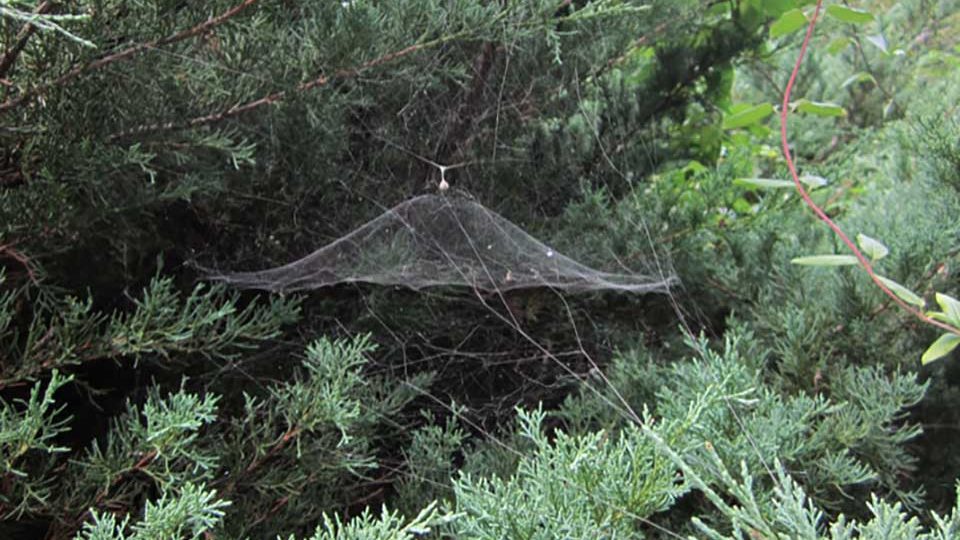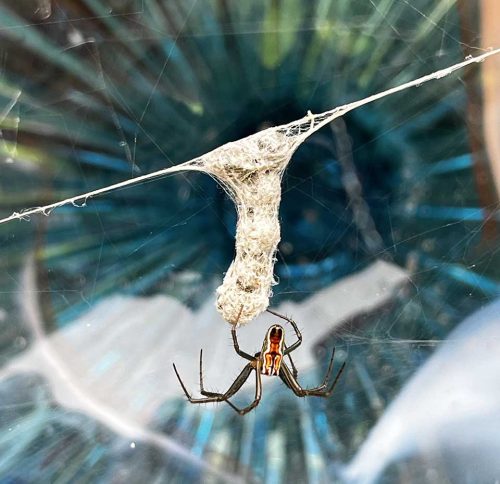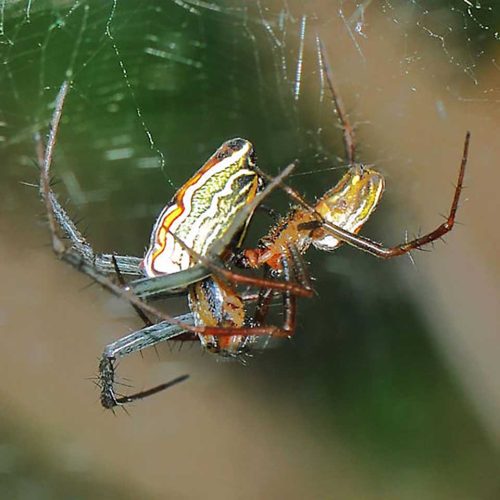Spiders, Oh My!
The aptly named orbweaving spider creates a web of intrigue—and stickiness.


The first book to make me cry, as I remember, was E. B. White’s Charlotte’s Web. In the story a pig named Wilbur befriends an orbweaver spider named Charlotte. Wilbur was the runt of the litter who was saved by the farmer’s daughter, Fern. As he matures Wilbur discovers the reprieve is temporary and his intended destiny is to attend Christmas dinner—not as a guest but as a main course.
Charlotte, a barn spider, takes pity on Wilbur. She and a crafty rat named Templeton strategize a scheme to save him involving written messages formed in the web. Wilbur becomes a phenomenon of sorts, with people travelling from miles around to see the web-based commentaries (spiderweb that is; after all, the book’s copyright is 1952). Spoiler alert: the story climaxes at a county fair with a last message, “Humble.”
Wilbur wins a special prize that gives him amnesty and slaughter is no longer in the cards. However, Charlotte is too weak to go back to the farm. She dies, but her progeny returns to the barn via Wilbur transporting her eggs. Tears of sadness. Because orbweavers live for only one season, subsequent generations of spiders must play the role of confidant that Charlotte fulfilled. Tears of sentimentality.
 So one wonders how it is that so many of us who read Charlotte’s Web went from crying about a spider’s death to crying out when one lands on us. Well, I’m not really certain. I remember being so very upset when Charlotte’s fate became clear. It may have even been one of my first confrontations with death, but life does go on.
So one wonders how it is that so many of us who read Charlotte’s Web went from crying about a spider’s death to crying out when one lands on us. Well, I’m not really certain. I remember being so very upset when Charlotte’s fate became clear. It may have even been one of my first confrontations with death, but life does go on.
I’m going to confess that if a spider runs across my arm or lands in my hair, I am far from embracing the occasion. In fact, I find myself flailing about; after all, I know all spiders are venomous. But I also know they are beneficial. As such my more intellectual side beckons me to check them out—when they are not invading my personal space.
Just this week I decided to identify the little beasties that cover the glass sculpture that my husband constructed in our courtyard. These spiders don’t just take advantage of the framework that holds the glass; no sirree, they have nearly draped the whole thing in a cocoon of threads. And then there are little dingle-ball egg cases that hang everywhere for good measure. Now all we’re lacking is a pig in need of a therapy session to complete the little courtyard drama.
On close inspection they are indeed decorative. They have green legs while the abdomen, I’m told, is white, and I also see brown with decorative patterning. I suppose it depends on what you consider the field and what you consider the markings. Anyway their half-inch bodies are green, brown, and white, with yellow lines and patches of red-orange. By anyone’s estimation they are ornate. You might need a magnifying glass to appreciate them fully, depending on your eyesight. Theirs? Eight eyes to be exact. They are said to have poor vision and rely upon vibrations in the web to locate their prey. That is why if you touch the web ever so slightly they may seem to charge toward your finger.
According to some accounts, male suitors are no longer around at the height of summer. They perform their inseminations and vacate the scene and die, if they aren’t unfortunately mistaken for prey by their date. The females are left to weave their webs and tend their eggs. These are basilica orbweavers, Mecynogea lemniscata, so-called because their webs are rounded like a basilica’s dome.
In spite of spiders’ nasty reputations they benefit humans. Scientific studies have clearly established the important role they play in agricultural lands and native environments, and even in buildings. Admittedly I’m still too intellectually immature to share my home with them intentionally. Besides, I like to tell myself that there are more pests available for them outside than in my house.
Our spidery predators are small in size so they rely on abundance to play a key role in our environment. Density estimates of spiders range from hundreds to millions per acre. One study concluded that spiders accounted for more than half of the predator biomass in the forest community (Bradley).
The adult basilica orbweaver’s web is dome-shaped and measures up to about 20 inches. But the spiderlings fashion perfect orb webs, like bicycle spokes with weavings placed in concentric circles at rather equally placed distances. The adults accomplish the dome by attaching threads both above and below the web. The male’s web is smaller than that of the female, also domed and built in close proximity to hers.

The females place their egg sacs vertically and hang them by a thread. They are round, three to four millimeters in diameter, and each contains eight to 30 eggs. Every night the spiders detach their webs, allowing the silky material to drape over the sacs to provide another layer of protection. This is primarily a characteristic of this species and not spiders in general. The scientific name lemniscate translates from Latin to “hanging ribbons,” in part descriptive of the suspended eggs. Their resulting appearance is that of a string of beads.
I suppose they don’t place all the webbing over the sacs because it looks to me like that amount of biomass would obscure them completely. The eggs take about 16 days to hatch, which would also result in a buildup of far too much material. Furthermore, spiders are recyclers, consuming their web and recreating it from the same substance.
They produce web silk from glands in their abdomen and secrete it from special fingerlike appendages at the end of the abdomen called spinnerets. Each spinneret has multiple microscopic spigots through which the protein-based silk is excreted. The molecular structure of the liquid is arranged such that it becomes an elastic fiber. Some strands are sticky and some are used as anchor lines—generally the bicycle spokes as previously mentioned.
Normally orbweavers would not be nesting in glass sculptures but rather in a forest’s low shrubs, three to six feet above the ground. They eat beetles, flies, wasps, and plant bugs. Their various means of capture have been documented by scientific observations; 16 different strategies have been identified, from biting, to wrapping, cutting, carrying, shaking, and so on. It is both gruesome and amazing.
For now just let me say that when I walk into a spiderweb I’m still likely to find myself flailing about. And after reading the details of capture I’ve decided to feel justifiably frenetic about the lovely little beasts.
Sources:
- Common Spiders of North America, Richard A. Bradley
- Arachnids of North Carolina, North Carolina Park System
- North Carolina Extension, “Basilica Orbweaver Spider,” PDIC Factsheets
- Spider of the Week: The Basilica Orbweaver, Emma I. Dietrich, PhD
- ITIS – Integrated Taxonomic Information System – range data









